Even if you travel to the ends of the Earth to reach the perfect bug out location, or you think you have everything accounted for in a bug in scenario, your survival may depend on the contents and security of a single room.
Some people feel panic rooms are useless, or that escaping is always a better option, but a panic room is really useful until immediate dangers pass.
When used with awareness of the pitfalls of panic rooms and within the context of a comprehensive survival plan, panic rooms can save your life. Here are the right answers that will help you turn your panic room into the safest location on earth.
You Need Safe Entrances and Exits
Some preppers disregard the usefulness of panic rooms because once you go into the room, there is usually no other exit. If someone that intends to cause you harm finds the entrance or manages to break in through some other part of the room, you will have no way to escape.
Is there any way to solve this issue? I think there are some ways you can try to mitigate this problem and still have a panic room located close enough to where you live. Here’s what to do:
- Have at least two entrances or exits to the panic room. One should be well hidden in a wall or some other area where it will not be easily found. The other entrance should lead underground or through some other route that would not be easy to follow.
- Both entrances should be booby trapped so that they are destroyed once you pass through them (use the traps only if you want to prevent others from reaching you.) For example, if you have an entrance behind a closet in your home, set traps so that the building or parts of it near the entrance collapse. Even if someone enters the home looking for you, it may take a few hours, or even a few days before they are able to find the doorway or the panic room. If you must exit the panic room by the second doorway, make sure that no one can follow you by setting the entire room to collapse.
- If you are escaping through an underground tunnel, or moving from tunnels, through crawlspaces, or other unusual routes, do not forget to booby trap them as well. Remember, you won’t be trying to go back along the way you came, but you may need to slow attackers down as they pursue you.
- City dwellers and others that rely on building shafts or underground tunnels should travel through these areas at least 3 – 4 times a year. Make as many diverse routes and maps as possible, plus be aware of all risks associated with being or surfacing in certain areas.
Get Electronic and Manual Surveillance
If you are going to box yourself and your loved ones into a room, you still need to know what is going on in the world around you. Cameras and surveillance equipment may seem important, however, they can fail at the wrong moment, be tapped into by adversaries, or even alert others to the fact you may be hiding somewhere nearby.
That’why, before purchasing and setting up these devices, always make sure that you know what their vulnerabilities are, and whether or not you can get around them.
Rather than rely solely on electronic surveillance equipment, consider some manual methods that can be used regardless of the situation. When building your panic room, look into different natural acoustic systems that will enable you to pick up different sounds around you without revealing your presence.
Use these listening posts in combination with dogs, insects, or other animals that will either make noise, or stop making noise when someone else is around. You can also use mirrors set at different angles to see further into nearby rooms that are located near the entrance of your panic room.
Don’t Forget About Secure Communications
Great care must be taken when choosing communications equipment for the panic room. Not every situation will be one in which you don’t want others to find you.
For example, if there is a tornado or other natural disaster, you’ll need to be able to call out to rescue teams or anyone else that can get to you, so keep a cell phone with you, and also a ham radio.
When setting up the panic room, make sure that you can get a signal out so that you can call for help. Or you can install phone lines and other communication lines in such a way that they won’t be destroyed in a disaster scenario.
Considering the way the world is going these days, there may be times when you need to reach out to other survivors without drawing attention from rioters or others that might harm you.
In these cases, cell phone, radio, and most other signals can lead attackers right to you, so you could try using trained carrier pigeons or other animals that can be relied on to deliver messages. It will take more time than you like, but it may be better than doing nothing at all.
Depending on the distances involved, spark gap generators combined with unique codes similar to Morse Code may be of use. If there are other survivors that may take to panic rooms in your local area, you can set up acoustic pathways between buildings or along underground paths that can be used to transmit tapping or banging sounds.
Trained animals may pick up these sounds at greater distances and be used to draw other survivors to a place where they can better hear the signals being sent. Just remember that prospective attackers may also have trained animals available to pick up sounds. This is why working out a unique code that is only known to those you trust is very important.
Basic Daily Living Need Supplies to Store
Food, water, hygiene products, medications, first aid kits, clothing, and other basic items are important to be stored in your panic room. Since you may be staying in for days, weeks, or even months, there are some other things that could help you survive:
- Blankets and other equipment that you can use to keep warm or cool off
- Weapons for your defense
- Verified safe mushroom starter kits for mushrooms that will mature in just a few days or weeks, and seeds for sprout gardens
- Insect farms and necessary eggs for growing and maintaining successful colonies
- Lighting and soil sufficient for growing key herbs that can be used to manage medical and first aid needs.
- Zeer pots and ice/salt chests that can be used for refrigeration. You might be preparing most of your foods from fresh sources, and you’ll need at least some refrigeration onhand.
- Printed reference or “how to” materials that can be used to help you manage different needs while in the panic room. Since modern computers and cell phones all contain tracking chips, keep them off and with the power source (including backup batteries) disconnected to protect your location. Rely on printed materials as opposed to looking them up on an electronic device.
- Fire starting and other basic emergency gear that you can take with you if you have to leave the panic room. Try to fit everything into a single “bug in” bag so that you can live mainly from that bag and travel at a moment’s notice.
- Simple hand tools such as screw drivers, hammers, nails, wrenches, measuring tapes, sewing kits, wrenches, crowbar, ax, and saws, and maybe goggles, ear plugs, and dust masks. You probably won’t be doing much with these tools while you are in the panic room, but they might become useful if you have to plan your way out.
Is It Secure From Information Gathering Methods?
One of the most important things about a panic room is that it must be difficult, if not impossible to detect. Unfortunately, most people stop at sound proofing and do not consider other technologies that can be used to find panic rooms above and below ground. Since this technology is always changing, do you research to figure out how to best secure the room.
For example, not so long ago, an underground bunker or panic room was considered best because few things could detect the outline of the room or what was inside. Today, ground penetrating radars can easily reveal the location of a panic room and also the exact location of the exits.
If you decide to have the panic room above ground, be aware that there are now systems that can “see” inside houses and reveal the presence of guns, people, and anything else of interest. Make sure that the room will not reveal itself on thermal imaging sweeps as well as ones designed to pick up different kinds of objects within a location.
In just about every case, the way things are distributed through the room will be a key factor. For example, if you have water stored in the panic room, break up the locations so that the box-like shape of the cases doesn’t register. Always try to make everything either look like a natural formation (for the setting in question) or so small that a single item would be mistaken for some kind of debris or simply seem to belong there.
Make the size and shape of the room as irregular as possible. For underground panic rooms, study how underground caves and caverns look. Think about how entrances, exits, and tunnels can be disguised so that even if they are detected with various kinds of equipment, they will be overlooked.
If the panic room is located in a wall or some other part of a building, make it look like a space that no person would be living or hiding in. If necessary, store your caches of equipment in different areas that you can get to easily enough. Make sure that all paths between caches are also protected from different kinds of surveillance equipment.
Choose Walls, Floors, Ceilings, and Doors that Cannot Be Breached
Do you fear the panic room won’t resist? Here are just a few things that the walls of a panic room must be able to withstand:
- Bullets, grenades, or any other propelled munition – sand bags, earth, and thick layers of cement may be your cheapest and best options.
- Nuclear radiation – earth and water will be your two cheapest options. While lead can also stop nuclear radiation, it takes very thick walls to be useful.
- Electrical discharges or EMP waves – surround the room with a Faraday cage. Contrary to popular belief, underground rooms can also be susceptible to electricity. When hunting for earthworms, all you have to do is stick electrodes in moist ground, and the electricity will cause them to surface. If someone is determined to harm you or drive you from the panic room, consider that they may decide to use high voltage.
- Flooding – in a natural disaster or some other situation, flooding may be the biggest threat to your safety. Make sure the room is waterproof and can also withstand large amounts of water flowing around it.
- Mechanical force – no matter whether your panic room is in a building or underground, earthquakes, bombs, or other powerful mechanical forces can easily cause everything around you to crumble. The panic room needs to be well fortified so that the walls, ceiling, and floors do not give way. If at all possible, try to make the outer area of the room somewhat egg shaped and not tethered to anything around it. At the very least, if something comes crashing down or around the panic room, it may be pushed out of the way instead of absorbing the entire crash. You can also use extended walls as energy absorbers much like the way crumple zones are used to absorb the force of a crash in modern cars.
- Temperature fluctuations – when you are stuck in a room with no place to go, it may be harder than expected to control the temperature. Choose materials that insulate well so that you need as little fuel as possible to change the temperature. Together with that, at least the inner layers of the panic room walls, ceiling, and floors should be able to disperse humidity that gathers up in the room. You may want to keep the humidity in the room and condense it to form water, or let it escape through an intermediary layer in the wall system. Aside from being very uncomfortable, excess humidity can also lead to the buildup of mold, mildew, and algae. Making sure the walls can vent properly is very important if you wish to stay healthy while in the panic room.
Capacity to Renew and Recycle
One of the most important, but overlooked part of panic rooms is the capacity to renew and recycle everything that is used or produced in the room. Water, food, and medicine usually run out sooner than later.
You must be able to grow your own foods, produce herbal medicines, and produce water. As icky as it may sound, that means you will need to be able to recycle urine and feces as opposed to simply looking for ways to dispose of it.
Learn about different composting systems and also water purification methods, which includes making sure that you know how to eliminate pathogens, and also work safely with waste materials. If at all possible, put an annex onto the panic room where you can take care of these matters. Some other things you should be able to do in the panic room include:
- create compost from cooking waste and scraps
- make paper from scraps and bits
- use tin cans, plastic bottles, or anything else found in the room to your advantage.
Power and Lighting
If you build your panic room to be as secure as possible, chances are there won’t be any windows, so you will need a secure and renewable source of lighting that does not include making fires. Here are some things you can try:
- Generate electricity using exercise equipment, body motion gear, and gravity fans.
- Know how to use tin foil and other reflectors to concentrate light so that you can grow a larger range of plants.
- Keep LED bulbs on hand and make sure that you have the proper sockets and power supply boards for them.
- Make sure that everything in the room can run on 9 volts or less. You should also know how to make earth batteries and other low-tech batteries
If you can make light and mirror tunnels, maybe you can get light from the outside into the panic room. Remember that even one small mirror or what looks like an air or access shaft can give away your presence or allow toxic fumes, pathogens, or other dangerous materials into the panic room.
No matter how secure you feel about your store of flashlights and batteries, make sure that you can improvise every single part of a lighting system from within the panic room. Light is absolutely essential for plant growth, and also for carrying out many daily activities.
Along with electricity, you may need some other fuels for cooking and keeping the room at a comfortable temperature.
You Need Air Purification
No matter how large or small the room is, you must be able to renew oxygen levels in the room, otherwise you will suffocate. Use multiple methods so that if one fails, you have another means to achieve this goal:
- Choose plants that absorb carbon dioxide and release oxygen regardless of whether it is day or night.
- Use a combination of ventilation shafts and filters so that you can remove contaminants from air that will be released into the room. You can study the filters used in biohazard, nuclear, chemical hazard, and dust respirators to see which materials to use in the air purification system. Since many of these materials need to be replaced on a routine basis, you should either know how to recharge the materials or make replacements from scratch
- Keep chemicals on hand that will release oxygen when mixed. This would be an emergency system that may give you a few extra hours while you repair other systems or prepare to exit the room.
Remember that oxygen concentrators do not produce oxygen. Rather, they take oxygen from the air and deliver it through narrow tubes so that more reaches the person in need of extra oxygen. In an airtight panic room, an oxygen concentrator will not be of use unless it can actually produce more oxygen, and then release it into the room.
It Has to Be Defendable
The basic idea of a panic room is that you will be safe from anyone that might try to harm you. On the other side of the equation, thousands of people that have hidden out in panic rooms have been captured or died because the location of the room was discovered.
As a last ditch resort, you should have some kind of weapons on hand so that you can stave off attackers long enough to escape, or take out as many as possible before they capture or kill you. You will also need weapons that can be used once you leave the panic room. Here are some things that may be of use:
Since the panic room is going to be fairly tight and cramped, you will need to lead intruders to kill zones where you either have traps set up, or where you can attack with ease.
A low caliber handgun may be more useful than a rifle or other gun with more stopping power. Remember that if the walls, doors, ceiling, and roof are well fortified, bullets are also likely to ricochet off them. You can try building in a bullet absorbing layer, however lower caliber rounds may still be your best option.
Have bullet proof helmets, vests, and other gear for you and everyone else in the room. If you do have to shoot, or you wind up being shot at, this gear may keep you from getting killed. If you are hit while wearing bullet proof gear, you can expect bruises, broken bones, and other injuries.
Swords, knives, spears, bow and arrow, slingshots, monkey fists, axes, poison darts and other hand combat weapons may be of use. Be sure to carefully study different kinds of bullet proof and weapon proofing gear so that you can get through any kind of armor with your weapons.
Depending on your outlook, you may also want to rig the panic room up so that it will blow up and take everyone with it. As a last resort, if you cannot escape, and do not want to be captured, this may be your last and final option.
A number of things must be carefully considered when building a panic room, where you can recover, regroup, and gather strength after a major disaster. A panic room can also be a serious liability if you do not prepare for all the problems that can occur. From mold build up on the walls to cell phone signals revealing your location, even the most minute details can spell disaster.
If you do decide to build a panic room, try living in it for hours, days, weeks, and months. Once you know that you can live in the room for extended periods of time, and escape if needed, the room will truly be a key survival asset instead of just providing a false sense of security.
This article has been written by Carmela Tyrell for Survivopedia.


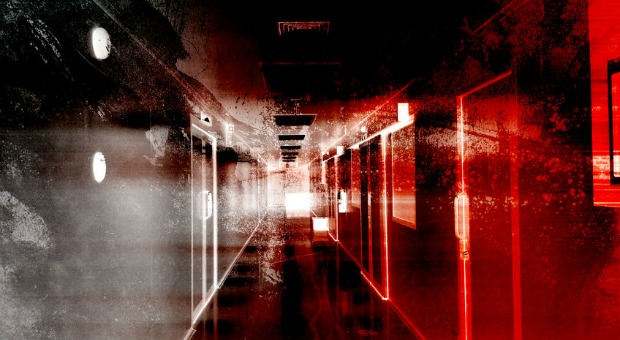
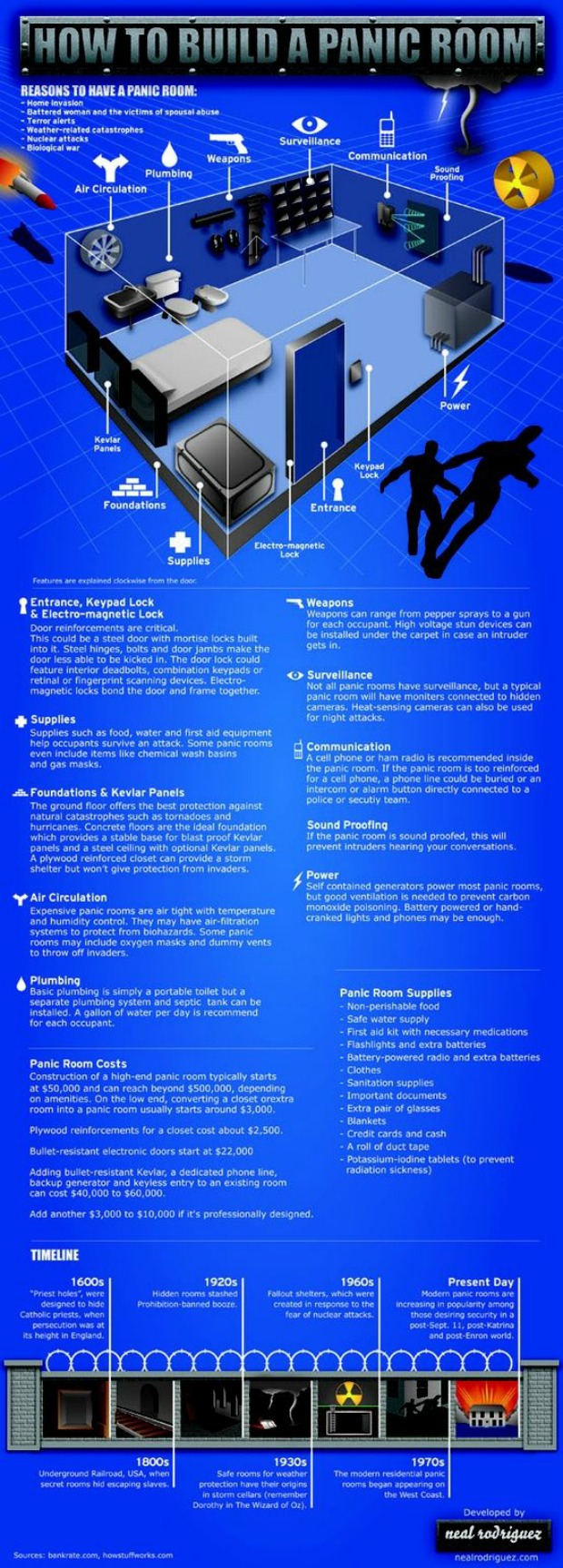

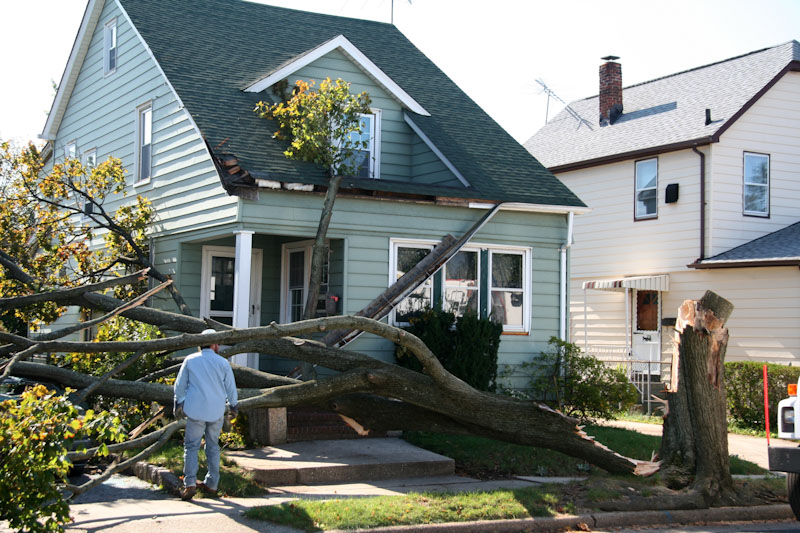
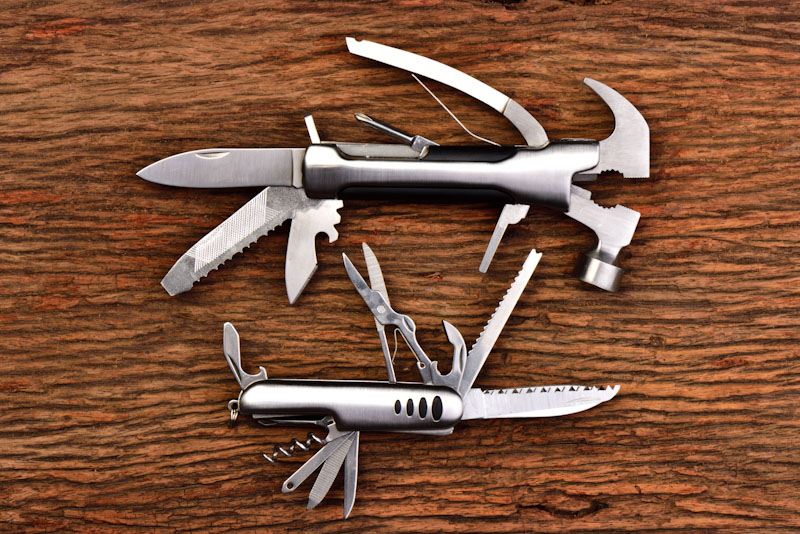
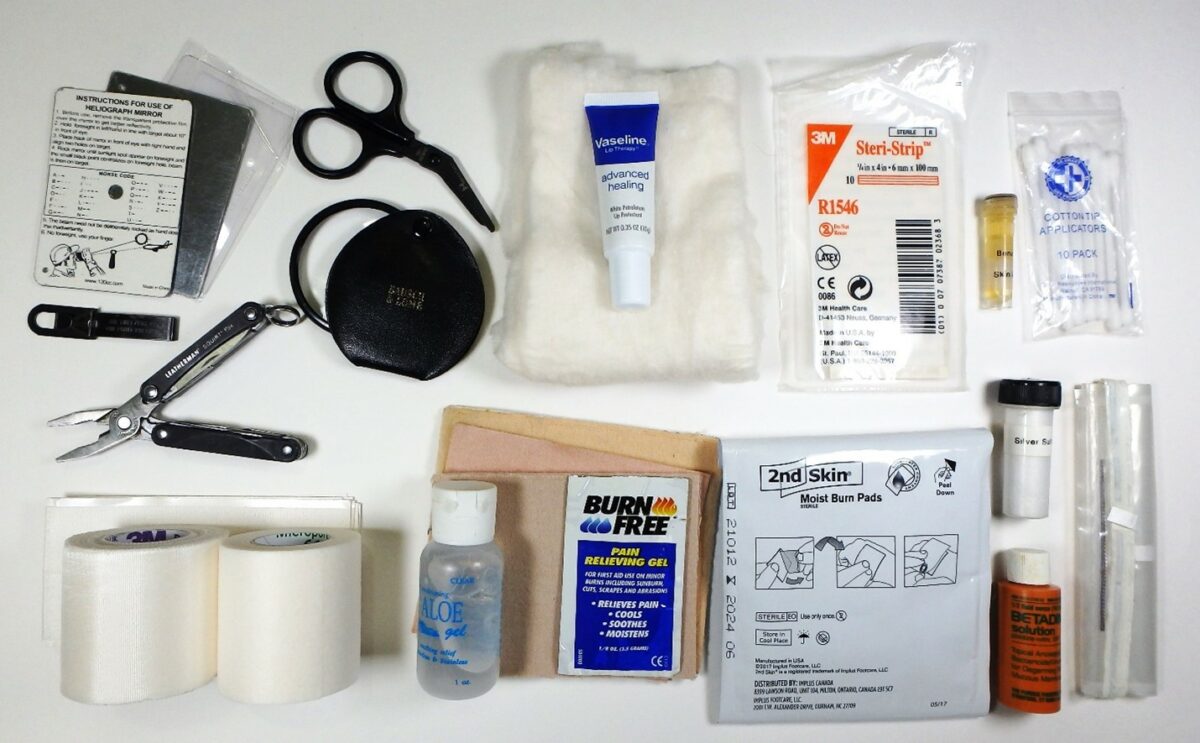


Adriaan | September 12, 2016
|
Thanks for the valued survival tips. Point taken. The necessity to get READY ASAP is a reality not to be overlooked.
Dropzone | September 12, 2016
|
I don’t mean to be harsh or mean spirited. I read the posts on Survivopedia on a regular basis and I rarely comment, but there are some posts that require me to due so based on the mis-information presented, I truly believe that this is not the intent, but some of the information in this post needs to be addressed.
Is this article about a bunker or a panic room? I’m confused……..
Is this based on pre or post SHTF ?
By any definition in my 30+ years of prepping, a panic room can never be a bunker.
Secure communications; really, trained carrier pigeons or other animals. OK what about smoke signals….!
Using spark gap communications within a EMP shielded “Panic Room” will produce ZERO results! Think about it.
Your story of fiction speaks to collapsible rooms in the event of the need to escape, then speaks to fortifications against rocket propelled explosives which will it be??
With a little more research I don’t think this line would have been included
“Generate electricity using exercise equipment, body motion gear, and gravity fans”.
These body in motion items in the “panic” room will generate heat, humidity, this activity will cause an increased water consumption and a higher demand for food intake. This could be a deadly endeavor if were truly trapped in the panic room.
The actual cubic feet of space to store all the items needed for self sustained survival for 4 persons (average family) (Bill, Nancy, Susie, and Bobbie) for weeks or months that is suggested would be huge for a “Panic Room”
You stated “On the other side of the equation, thousands of people that have hidden out in panic rooms have been captured or died because the location of the room was discovered.” How did you arrive at this conclusion, true panic rooms, in the modern era, do exactly what there designed to do provide short term protection of their occupants until the authorities arrive.
This is why a panic room and bunker are two entirely different things with very specific needs and uses.
Dean Wilkins | September 13, 2016
|
There’s a lot of thought and creativity that went into this, and a lot of other articles I see on here. There are some technical holes in the accuracy, but for the most part, good ideas. It’s great to be prepared for when/if times get rough. But with a lot of these kinds of articles, and especially in this case, I keep coming back to these thoughts: 1) Implementing all of this would require the assets of Bill Gates. It would require money from a government to build all this. 2) Even if you did have that kind of money to spend, if things got that bad in a SHTF, and you are able to survive, would it really be worth it? If people are coming in mobs of hundreds, and/or governments attacking you, would repelling an attack this time mean you’d be safe from now on? Nope. 3) What in the world do you own, that would induce an all-out attack on your “fort”? The government (in whatever form) would be more concerned with large-scale confiscating of valuables, than to expend so much energy and resources trying to take your 200 cans of soup, and some bags of seed. The government would be in search of large companies, warehouses, corporations, stores, etc.
My point is…..at some point, this all becomes unnecessary overkill….law of diminishing returns. It’s one thing to be prepared, but to me, the extent that some of this goes to almost borders on paranoia. If the underground, rad-hard, blast-proof, food/seed-for-a-year, bunker concept is designed to house/protect 5000 people, I could begin to see it being worth it. But not for a single family.
Dropzone | September 14, 2016
|
Dean,
I agree. There are good points to this blog issue, but some of the points simply will not work. A panic room for pre-SHTF in many cases are worth the investment(s) for the few hours of real need. In a post-SHTF, in IMHO, by having the appearance of not having anything worth spending the bad guys time on is more practical than 12 foot fencing, barricades, barred windows etc. just my 2 cents
G | September 13, 2016
|
Just because it’s a panic room, does not mean you won’t spend and extended time living in it.
As for phone lines the usual way they are fasten to a house almost guarantee that a tornado will destroy it if the house is destroyed. It needs to be on its on post at the very least, and phone line need to goto a junction box in your safe room by means that won’t be damaged by the being destroyed. The rest of the house is feed from the safe room junction box so you can disconnect damage wiring in the rest of the house. Also it will stop somebody in the house from taking a phone off the hook to stop you from calling for help or listening in as long you don’t have wireless hand sets in the house that work with your safe room phone.
Pingback:How To Survive With Kids In Small Spaces | Survivopedia | October 2, 2016
|
Pingback:9+ Essential Items For Your Bedroom Survival Kit | Survivopedia | February 3, 2017
|